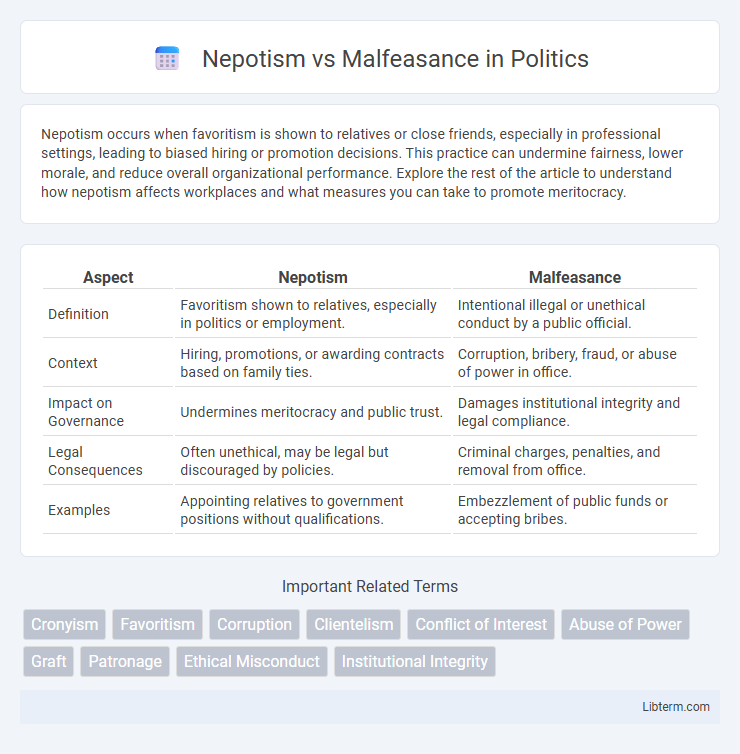Nepotism occurs when favoritism is shown to relatives or close friends, especially in professional settings, leading to biased hiring or promotion decisions. This practice can undermine fairness, lower morale, and reduce overall organizational performance. Explore the rest of the article to understand how nepotism affects workplaces and what measures you can take to promote meritocracy.
Table of Comparison
| Aspect | Nepotism | Malfeasance |
|---|---|---|
| Definition | Favoritism shown to relatives, especially in politics or employment. | Intentional illegal or unethical conduct by a public official. |
| Context | Hiring, promotions, or awarding contracts based on family ties. | Corruption, bribery, fraud, or abuse of power in office. |
| Impact on Governance | Undermines meritocracy and public trust. | Damages institutional integrity and legal compliance. |
| Legal Consequences | Often unethical, may be legal but discouraged by policies. | Criminal charges, penalties, and removal from office. |
| Examples | Appointing relatives to government positions without qualifications. | Embezzlement of public funds or accepting bribes. |
Understanding Nepotism: Definition and Origins
Nepotism refers to the practice of favoring relatives or close friends, especially by giving them jobs or positions of power regardless of their qualifications, originating from the Latin word "nepos," meaning nephew. This concept has historical roots in monarchies and religious institutions where rulers or leaders prioritized family loyalty over merit. Understanding nepotism involves recognizing its impact on organizational fairness, often leading to reduced morale and inefficiency.
Malfeasance Explained: Scope and Types
Malfeasance refers to intentional wrongdoing or misconduct by a public official or employee, often involving illegal or unethical actions. The scope of malfeasance includes bribery, fraud, embezzlement, and abuse of authority, all of which undermine institutional integrity and public trust. Unlike nepotism, which involves favoritism toward family members, malfeasance encompasses broader violations of law and professional standards that damage organizational effectiveness.
Key Differences Between Nepotism and Malfeasance
Nepotism involves favoritism toward relatives or friends in professional settings, prioritizing personal connections over merit, whereas malfeasance refers to the intentional wrongdoing or misconduct by a public official or employee. Nepotism primarily affects hiring and promotion practices, while malfeasance encompasses unlawful or unethical actions such as fraud, embezzlement, or abuse of power. The key difference lies in nepotism's bias in personnel decisions versus malfeasance's broader scope of illegal or unethical behavior impacting organizational integrity.
Impact of Nepotism on Organizational Integrity
Nepotism undermines organizational integrity by promoting favoritism over merit, leading to decreased employee morale and reduced trust in leadership. It distorts decision-making processes, often resulting in unqualified individuals in key positions, which can compromise performance and accountability. This erosion of ethical standards diminishes the organization's credibility and hampers long-term success.
Consequences of Malfeasance in the Workplace
Malfeasance in the workplace leads to severe consequences such as legal liabilities, financial losses, and damaged organizational reputation. Employees and stakeholders often experience diminished trust and morale, resulting in decreased productivity and higher turnover rates. Regulatory penalties and costly lawsuits may arise from corrupt actions, undermining business sustainability and stakeholder confidence.
Legal Implications: Nepotism vs Malfeasance
Nepotism involves favoritism based on family relationships and can lead to legal consequences under anti-discrimination and employment laws when it results in unfair hiring or promotion practices. Malfeasance refers to intentional misconduct or illegal acts by public officials or employees, often violating criminal and administrative laws, with severe penalties including fines, dismissal, or imprisonment. Legal implications of nepotism usually focus on breaches of ethical standards and workplace fairness, while malfeasance directly implicates violations of statutory duties and public trust.
Ethical Considerations in Addressing Nepotism
Addressing nepotism requires strict adherence to ethical principles such as fairness, transparency, and meritocracy to prevent favoritism that undermines organizational integrity. Implementing clear policies and impartial hiring processes helps mitigate conflicts of interest and reinforces accountability within institutions. Ethical frameworks prioritize equal opportunity, ensuring that decisions are based on qualifications rather than personal relationships, distinguishing nepotism from malfeasance which involves intentional wrongdoing or misconduct.
Strategies to Prevent Malfeasance
Implementing transparent hiring practices and regular audits significantly reduce the risk of malfeasance by promoting accountability and ethical behavior. Establishing robust whistleblower policies encourages employees to report unethical actions without fear of retaliation, enhancing organizational integrity. Leveraging technology for monitoring transactions and decision-making processes ensures early detection of fraudulent activities and limits opportunities for misconduct.
Case Studies: Notable Examples of Nepotism and Malfeasance
Notable cases of nepotism include the appointment of family members to key government positions, such as in the administration of former Philippine President Rodrigo Duterte, where several relatives held influential roles, raising concerns over conflicts of interest. Malfeasance examples encompass scandals like the Enron collapse, where executives engaged in widespread corporate fraud and accounting manipulation, leading to bankruptcy and legal consequences. These case studies highlight the impact of nepotism and malfeasance on organizational integrity and public trust, emphasizing the need for robust governance and transparency measures.
Building a Culture of Accountability and Transparency
Nepotism undermines meritocracy by privileging family ties over qualifications, while malfeasance involves intentional misconduct or unethical behavior within organizations. Building a culture of accountability and transparency requires implementing strict policies, regular audits, and clear reporting mechanisms to detect and prevent favoritism and corruption. Transparent leadership fosters trust and ensures decisions are based on fairness, competence, and ethical standards rather than personal relationships or illicit actions.
Nepotism Infographic

 libterm.com
libterm.com